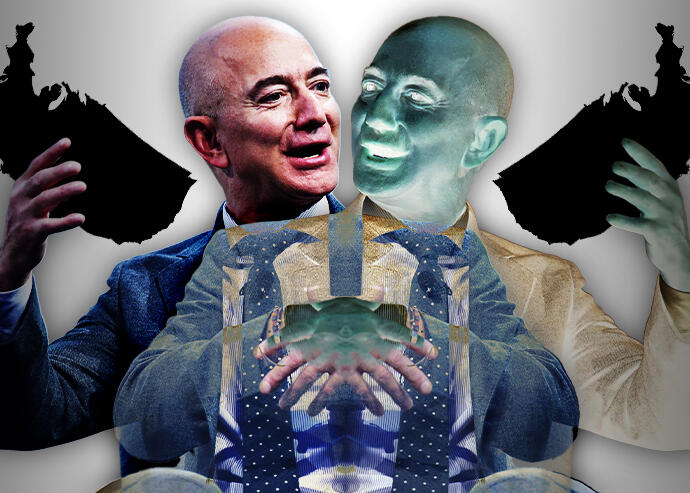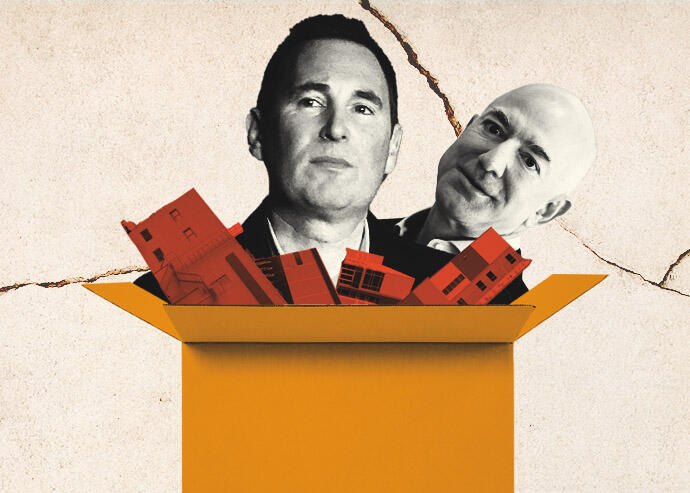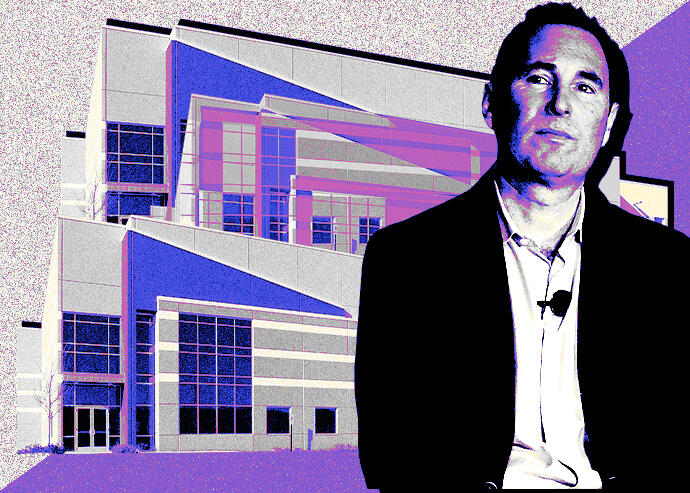
As Amazon Gobbles Up Warehouse Space, NYC’s Suburbs Keep Giving It Tax Breaks
Multiple tax incentive deals for suburban e-commerce facilities are raising questions as to how much taxes counties should forgo to lure warehouses
Multiple tax incentive deals for suburban e-commerce facilities in New York in recent months are raising questions as to how much taxes local counties should forgo in order to lure the warehouses to their jurisdictions.
Local officials argue the tax breaks are a small price to pay to lure well-capitalized employers that will make use of dead space. But critics claim companies like Amazon, run by the world's wealthiest man, don't need tax breaks to develop warehouses they would likely build anyway.
In Syosset, a hamlet in Nassau County on Long Island, Amazon plans to build a 200K SF fulfillment center at a 39-acre brownfield site that used to be home to a Cerrowire manufacturing plant. Amazon approached the Nassau County Industrial Development Agency a year ago, its chairman, Richard Kessel, told Bisnow, and the two sides ultimately agreed to a deal in which Amazon would pay a flat fee and be exempt from property taxes.
"The bottom line is that Amazon clearly indicated to us that they would not go on the site if they didn't get some help,” Kessel said.
Amazon plans to spend $72M constructing the building, which will create more than 200 full-time employment opportunities and 125 construction-phase jobs, according to the IDA. The payment-in-lieu-of-taxes deal equates to $1.9M annually for 15 years, compared to the $1M in annual taxes due on the vacant property.
“This is a win for everyone,” Kessel said. "Right now, it's an eyesore ... Ultimately, we've solved the riddle of a brownfield, created hundreds of jobs and made something of a vacant blemish on the Long Island Expressway here in the county.”
It is not the only suburban development authority providing incentives to spur e-commerce development. Late last month, the Mount Pleasant IDA in Westchester County announced it had approved about $3.8M in sales tax exemptions for a developer to build a 153K SF e-commerce distribution center in Hawthorne.
The development would generate 100 full- and part-time jobs as well as 1,000 construction positions and represents $99M in private investment, the IDA announced. A representative said the IDA doesn't know to whom the facility is being leased.
Earlier this month, Amazon leased a 422K facility on Rockaway Boulevard near the John F. Kennedy International Airport. Developer Wildflower Ltd. had scored $16M in economic development incentives from the Town of Hempstead IDA, and Wildflower will hand over a one-time payment of $250K to the Lawrence Union Free School District, after the district sued to lower the length of the tax incentives given to the developer, Newsday reported.
Representatives from the IDA called the deal “incredibly exciting.” Amazon is coming, but the IDA said it was not aware of its involvement when it was negotiating the tax breaks with the developer of the site.
In an email, an Amazon representative noted that receiving financial assistance from an IDA is standard, and that the tech company has created 34,000 jobs in New York since 2010.
But KC Conway, the chief economist for the CCIM Institute who specializes in industrial real estate, adaptive reuse and property tax, is urging local officials to tread carefully, and not undersell their assets.
“Amazon has huge datasets where they know where the packages are going. They know the density, they know the proximity to key infrastructure elements,” he said. “They're coming there regardless of the incentive.”
He added that often Amazon and other manufacturing or logistics companies don’t deliver on what they say they will do, and noted some of Amazon's fulfillment centers are moving away from manual labor — which will cost jobs.
“I would encourage more of these local governments to be thinking carefully about what Amazon's doing and how much more automated and robotic it's getting,” he said, noting the company's recent opening of a robotics-powered center in Stone Mountain, Georgia.
There is no doubt Amazon was already doubling down on Long Island. It leased a 110K SF logistic center in Shirley last August, and it has indicated interest in building a last-mile site in Melville, according to Newsday. Its plans for the Cerrowire site, however, bring decades of community and political infighting about how the site should be used to a head.
But Martin Cantor, a former Suffolk County economic development commissioner, said scoring Amazon is the worst possible outcome for the land.
“They should never have given incentives for a warehouse,” he said. “They should never give an incentive to Amazon. Amazon doesn't need incentives, and we shouldn't be giving incentives creating minimum wage jobs.”
He claims the deal was done because officials wanted the “big hit name” of Amazon for the community, and that any other form of development would have addressed the contamination issues on the site as well.
“The county executive is in a re-election year," Cantor said. "The agency wants to show it's doing something.”
Certainly, the words “Amazon” and “incentives” garner headlines. The company's plans to build its second headquarters in Long Island City were scuttled in 2019, after widespread backlash over the $3B in tax incentives the city and state had agreed to give. When the company took 335K SF in office space some seven months later at Hudson Yards, without tax breaks, HQ2 critics said they were vindicated.
“Unlike the folks in Long Island City, we see the benefit of jobs, economic development, both construction jobs, ongoing jobs and a productive piece of property,” said Frederick Parola, the CEO of the Hempstead Industrial Development Agency.
Last year, the IDA reached a deal to offer Wildflower a 15-year PILOT agreement and exemptions from mortgage recording and sales taxes to build a logistics center on an airport parking lot at 253-51 Rockaway Blvd. in Woodmere. In total, Wildflower’s breaks come to around $16M, with $14M off property taxes over 15 years.
This month, the IDA announced Amazon would take the building. Wildflower didn't respond to a request to be interviewed.
“The jobs ripple through the system, so if you have someone working locally, they're gonna buy food, they're going to perhaps on their break go out and buy clothing or other items they need, because it's convenient. So all of this is of assistance to the local economy,” Parola said, adding he only found out about Amazon around a month ago. “We’re not giving away the ranch, but [the developer] does get a benefit.”
There is no doubt there is significant industrial space as a whole in the outer boroughs. Rents for warehouse and distribution space in the boroughs outside Manhattan hit $19.70 per SF in the first quarter of 2021, per Cushman & Wakefield, and they are among the priciest in the nation after rising by nearly 5% over the past two years.
Alison Brennan, the CEO of First Development Corp., a property developer and manager based in Hauppauge, said Amazon’s interest in Long Island is, on the whole, a positive thing.
“There are definitely pluses and minuses … [but] it’s created a lot of jobs,” she said. “It helps with our infrastructure, but it does impact the industrial market and change sale prices and rent prices.”
Julian Bene, a former board member of Invest Atlanta — the equivalent of an IDA for the Georgia capital — has become one of the opponents of the city's incentive policies. He said an injection of Amazon warehouse jobs is not always a boon for the community.
“Jobs in an Amazon fulfillment center are not highly paid. And in fact, the work is by many accounts grueling, and people don't stay in it long because it's so unpleasant and arduous,” he said. “So, you know, what favors are we doing here?”
Ultimately, Conway said it is important that local counties make sure they put policies in place to hold companies like Amazon to account if they don’t meet their obligations.
“The biggest message coming out of 2018 and Covid is that local communities are going to have to do the math better to hold the entity like Amazon accountable for its economic impact,” he said.






